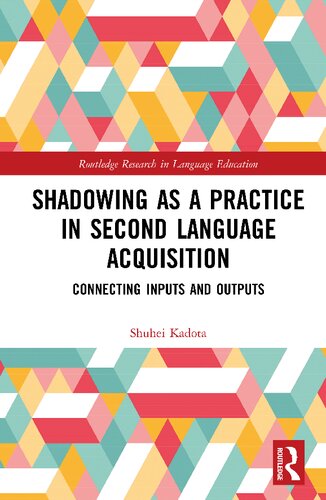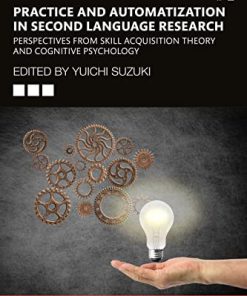Shadowing as a Practice in Second Language Acquisition Connecting Inputs and Outputs 1st Edition by Shuhei Kadota 1351049085 9781351049085
$50.00 Original price was: $50.00.$25.00Current price is: $25.00.
Shadowing as a Practice in Second Language Acquisition Connecting Inputs and Outputs 1st Edition by Shuhei Kadota – Ebook PDF Instant Download/Delivery: 1351049085, 9781351049085
Full download Shadowing as a Practice in Second Language Acquisition Connecting Inputs and Outputs 1st Edition after payment

Product details:
ISBN 10: 1351049085
ISBN 13: 9781351049085
Author: Shuhei Kadota
Shadowing is a theoretically and empirically well-examined method to develop L2 learners’ listening comprehension (input effect); enhance their subvocal rehearsal mechanism in the phonological working memory for learning new words, formula, and constructions (practice effect); simulate some stages of speech production (output effect); and develop metacognitive monitoring and control by their executive working memory (monitoring effect). In Japan and some other Asian countries, shadowing is a well-recognized, popular method of learning English and Japanese as L2, and this book offers the chance for anyone new to this method to benefit. Through the research contained within this book, readers will be armed with detailed and useful accounts of the four effects above (i.e. input, practice, output, and monitoring effects) from a theoretical and empirical viewpoint.
Shadowing as a Practice in Second Language Acquisition Connecting Inputs and Outputs 1st table of contents:
1 What is shadowing?
1.1 What is shadowing?
1.2 A sample of L2 shadowing
1.3 Repeating, oral reading, and parallel reading
1.3.1 Repeating
1.3.2 Oral reading
1.3.3 Parallel reading
1.4 The proposed effects of shadowing
2 Shadowing for L2 listening comprehension
2.1 A simplified sketch of L2 listening comprehension
2.2 The two stages of listening: Perception and comprehension
2.3 Switching between perception and comprehension in listening
2.4 Theoretical background of the effect of shadowing on speech perception
2.4.1 McGurk effect
2.4.2 Motor theory of speech perception
2.4.3 Roles of the ventral and dorsal streams in speech perception
2.4.4 Mirroring system
2.4.5 Cerebral activation by shadowing: A neuroscience study
2.4.6 What does the activation of Broca’s area by shadowing imply?
2.5 The effectiveness of shadowing during L2 listening: Recent empirical studies in ESL and JSL
3 Shadowing for promoting L2 learnability
3.1 Subvocal rehearsal for transforming inputs to long-term memory: Explicit and implicit intake
3.1.1 Human information processing system: An overview
3.1.2 Human memory system
3.1.3 Baddeley’s working memory model
3.1.4 Phonological loop (phonological working memory)
3.1.5 The interface between the phonological loop and long-term memory
3.1.6 Phonological loop as a language acquisition center
3.1.7 Conduction aphasia
3.1.8 Phonological working memory capacity as a language learning aptitude
3.2 The effectiveness of shadowing in promoting vocal and subvocal rehearsal in L2
3.2.1 Phonological coding in processing a single L1 English word
3.2.2 Phonological coding in processing a single L2 English word
3.2.3 Phonological coding in silent reading in L1 English
3.2.4 Phonological coding in silent reading in L2 English
3.2.5 Implicit prosodic configuration in silent reading in English
3.2.6 Shadowing as an overt vocal rehearsal and its relation to covert vocal rehearsal
3.2.7 The effect of shadowing on the subvocal rehearsal in L2 silent reading: Experiment 1
Method and procedure
Results and discussion
3.2.8 The effect of shadowing on the subvocal rehearsal in L2 silent reading: Experiment 2
3.2.9 The transfer effect of shadowing to subvocal rehearsal in phonological working memory
3.3 The effectiveness of shadowing in L2 intake: Recent empirical studies in English and Japanese as L2
3.3.1 Long-term memory revisited: How knowledge is stored? Types of LTM
3.3.2 Explicit vs. implicit learning and the interface between them
3.3.3 Shadowing as a way to enhance implicit learning
4 Shadowing for L2 speech production
4.1 Basic features of speech in everyday communication
4.2 Outline of L2 speech production
4.2.1 Speech encoding errors
4.3 Effect of shadowing on L2 phonetic encoding and articulation
4.4 Simulating L2 sentence production through shadowing practice
4.5 Effectiveness of shadowing in L2 lexico-grammatical encoding
4.6 Effectiveness of shadowing in L2 speech: Empirical studies in ESL and JSL
4.7 Effectiveness of shadowing by L1 speakers in assessing L2 speech
5 Metacognitive monitoring and control
5.1 Metacognition in L2 Acquisition
5.1.1 What is metacognition?
5.1.2 Types of metacognitive knowledge
1) Knowledge about persons
2) Knowledge about cognitive tasks
3) Knowledge about strategies
5.1.3 Metacognitive activity: Monitoring and control
5.1.4 Metacognition and the frontal association cortex
5.1.5 Monitoring and executive functions of working memory
5.2 Research into L2 metacognitive monitoring and control
5.2.1 Think-aloud protocols in L2 acquisition
5.2.2 Developing metacognitive monitoring by shadowing training
5.2.3 Effect of metacognitive control in L2 oral reading
5.3 Dementia and bilingualism
5.3.1 What is dementia?
5.3.2 Association between bilingualism and age at onset of dementia
5.4 Metacognitive monitoring, executive function, and L2 acquisition
6 Establishing a new concept of practice in L2 acquisition
6.1 Outlining a likely innate learning system
6.1.1 Our learning system
6.1.2 Input theory
6.1.3 Output theory
6.1.4 Interactional theory
6.2 Psycholinguistic competence: An index for proceduralization of language use
6.3 Establishing a new concept of practice in L2 acquisition
6.3.1 Practice connecting input processing and output production
6.3.2 Old concept of practice
6.3.3 A new concept of practice: Practice as a priming process
6.3.4 Practice for automatized explicit knowledge: DeKeyser
6.4 Extensive reading/listening and shadowing as practice connecting inputs and outputs
6.4.1 Extensive reading as input-driven practice
6.4.2 Usage-based theory as applied to extensive reading
6.4.2.1 Usage-based theory in L1 acquisition
6.4.2.2 Usage-based theory in L2 acquisition
6.4.3 Shadowing as output-driven practice
6.4.4 Implicit acquisition of formulae
6.5 Summary and perspectives
6.5.1 Locating shadowing in a simplified model of bilingual processing
6.5.2 IPOM: Input, practice, output, monitoring
6.5.3 Summary of the four effects of shadowing
6.5.4 Order of emergence of input, practice, and output effects
6.5.5 Hypothetical route map to L2 acquisition through shadowing
People also search for Shadowing as a Practice in Second Language Acquisition Connecting Inputs and Outputs 1st:
what is shadowing in language learning
language learning shadowing technique
does language shadowing work
slp shadowing opportunities near me
shadowing a language
Tags: Shadowing, Practice, Second Language, Acquisition Connecting, Outputs, Shuhei Kadota
You may also like…
Reference - Writing
Routledge Handbook of Arabic Second Language Acquisition First Edition Alhawary
Politics & Philosophy - Social Sciences
Second language acquisition 1st Edition by Slabakova 0191072192 9780191072192
Education Studies & Teaching - Teaching - Reading & Language
Project Based Learning in Second Language Acquisition 1st Edition Adrián 0429854714 9780429854712
Education Studies & Teaching
Chinese as a Second Language Assessment 1st Edition Dongbo Zhang
Linguistics - Linguistics
Second Language Acquisition and Lifelong Learning 1st Edition Singleton
Uncategorized
Politics & Philosophy - Social Sciences
Education Studies & Teaching - Teaching - Reading & Language











